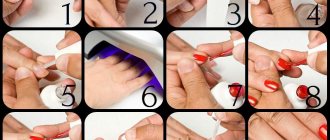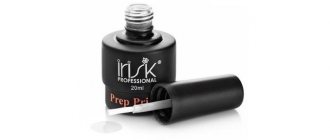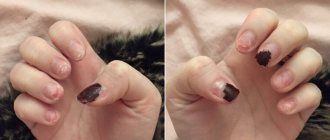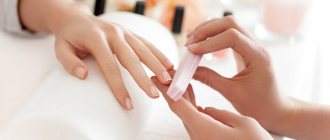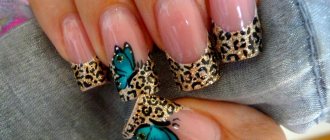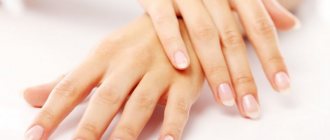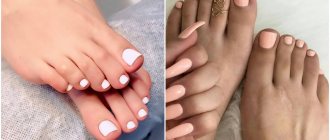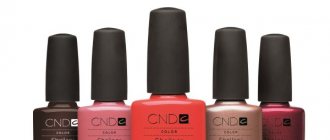Over the past few years, shellac manicure has become one of the most popular beauty procedures, which is included in the list of services of almost every beauty salon. The main advantage of this coating is its durability (up to 4 weeks without chips and cracks), although many experts agree that there are some disadvantages here too. If you consider nail design an important element of your image and at the same time care about the health of your nails, we will tell you what is important to know before a manicure, how to properly remove shellac at home and what procedures to pay attention to in order to minimize its harm.
Photo: unsplash.com
Pros and cons of shellac
In addition to durability, shellac has several other advantages. For example, a varied palette, high color saturation, the ability to remove at home, the absence of toxic substances in the composition, as well as a glossy shine. In addition, some girls use shellac to grow their nails: under a thick layer of coating they do not peel off or break, but the main thing here is not to damage the plate while removing the varnish, otherwise they will have to be filed down and repeated all over again.
The main disadvantage of shellac is that it must be dried under an ultraviolet lamp, the light of which negatively affects the skin, so if you want to protect yourself, apply cream with spf on your hands before going to the salon. Nail polish removers also cause significant harm: they usually contain large quantities of acetone, which greatly dries out the nails, so after this procedure it is important to take time to restore them.
Perfumed mists and mists are the main beauty purchase of the summer
More details
Possible negative consequences after using gel coatings
So, let's look at the possible problems when using gel polishes.
- You were unlucky and you came across an inexperienced nail technician, or an overzealous one, and he filed down your nail plate almost to the state of tissue paper. Or perhaps the nail polish removal technology was not followed. Many people simply literally rip off the old coating with their “teeth”, removing the living fibers of the nail along with the varnish. And it also happens that the varnish turned out to be of poor quality or the nail was poorly degreased, and the coating peeled off the plate. And after 2-3 days you again ventured into the extension or coloring procedure. It turns out that the nail is cut down again and exposed to radiation in a lamp. As a result, you get thin nails, very sensitive to external influences, on which it is simply impossible to apply any coating. The plates react to even the slightest change in temperature.
- Another option is that you or your master uses low-quality cheap materials. As a result, the polish chips along with pieces of the nail, or the nail cracks right under the polish. The plate turns yellow, becomes covered with white spots and deep grooves appear. Nails become brittle, chip, peel, and break before they even have time to grow. It is impossible to reapply varnish on such nails; there is simply nothing for it to hold on to.
- Your nails were overexposed in the lamp, or extensions were done very often, and the nail polish removal technology was not followed. As a result, calloused formations have formed under the thinning plate, which stick out unsightly from under the nails, and it is impossible to process the free edge of the nail due to painful sensations when touching the growth. In addition, dark streaks of dried blood are visible under the nails. And the skin of the hands in the nail area peels and looks rough.
- The worst consequence is that the plate was literally cut down to the “meat” and instead of a beautiful manicure, there is an open, raw wound.
- Another unpleasant moment is the resulting fungus. It appears when disinfection rules are ignored and hygiene standards are violated.
It is in these cases that they talk about the need to restore nails.
How to remove shellac at home

Photo: unsplash.com
To safely remove shellac at home, you will need:
- nailfile
- cotton pads
- nail polish remover with acetone (it is important that it does not contain care oils)
- foil
- orange wood sticks or metal pusher
- nutritious cream
To begin, cut out small blanks from cotton pads that are shaped like your nails - this is necessary so that the remover does not get on the cuticle and damage it. As much as possible, carefully file away the top layer of shellac - the thinner it is, the faster it will dissolve. Then apply the stencils soaked in nail polish remover to your nails, wrap them tightly with foil and wait 15 minutes. When the timer goes off, carefully remove the foil from your fingers and scrape off any remaining polish with an orange stick. At the end of the procedure, wash your hands and apply nourishing cream to them or make a special moisturizing mask in the form of gloves.
Express treatment and recovery within a day
Folk recipes, for all their simplicity and cheapness, require more time to achieve a noticeable result; salon procedures are more expensive, but work faster. But all of them will not be able to instantly return a damaged nail plate to a perfectly healthy appearance. A simple and safe way to change your image using the Irida tinted shampoo palette in this material.
But let’s try to figure out how you can at least partially restore the condition of your nails in an extremely short time:
- remove shellac;
- cut the nails to the root or short enough;
- make an oil bath for your hands;
- At night, apply a nourishing cream and go to bed wearing special textile gloves for hand skin care;
- We seal nails with wax in a salon or at home;
- Apply a protective varnish coating.
How to restore healthy nails
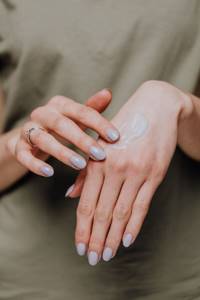
Photo: pexels.com
The condition of nails after shellac deteriorates, since shellac itself is a complex chemical compound that, under the influence of ultraviolet light, literally “melts” into the top layer of the nail plate and is removed along with it. Today, many experts agree that it is unsafe to do such a coating all the time; the optimal regime here would be the following formula: two manicures with a durable coating, and then a three-month break, during which you should pay special attention to caring for the health of your nails.
The first thing you should pay attention to in this matter is nutrition. Foods rich in calcium will help restore your nails (and your hair at the same time) - nuts, legumes, seafood, vegetables and leafy greens, which should definitely be included in your diet. Secondly, before applying care products, your nails should be thoroughly polished to remove any remaining varnish and provide oxygen access to them. You can do this at home with a special file. In addition, in the first weeks after removing shellac, it is recommended to carry out all household chores - for example, washing dishes - with gloves to avoid microtraumas.
Mewing - what is it and why is everyone talking about it now?
Read more
In order to restore the health of your nails, twice a day - morning and evening, apply special nourishing oils to them and to the cuticle, always with smooth massage movements. After they are absorbed, your hands can be additionally smeared with cream. Experts do not recommend using folk remedies to treat nails, as they can cause a severe allergic reaction and only worsen the situation. In the modern world, preference should still be given to certified cosmetics - masks, strengtheners and other products, especially since they can be found not only in luxury, but also in mass-market brands.
You can also restore nails after shellac using salon procedures. Here, the most effective are paraffin baths - when a warm composition of heated paraffin is applied to the hands, and “sealing” - when the nail is covered with a viscous product that contains honey and beeswax, which promote intensive nutrition and protection during the recovery period.
Why are nails soft, thin and weakened after gel polish?
Before looking for a solution to the problem, let's consider why nails after gel polish are soft, weakened and thin. Shellac is a kind of hybrid of extension gel and decorative varnish, which, along with their best properties, also incorporates some negative aspects. The coating is made on the basis of natural resins, applied to the polished nail surface and dried by polymerization under a lamp (UV or LED). Considering all of the above, it is not difficult to guess what is damaging the nail plate:
- grinding (before applying the material, the master must file down the top smooth layer of the nails so that the surfaces become slightly rough, and the more the master “overdoes it,” the thinner the plate will become and the longer it will take to restore it);
- after applying shellac to the plate, access to air, sunlight, and nutrients will be blocked (useful components after masks, baths, creams, which are necessary for daily care of hands and nails, will not pass through the material);
- The immediate stage of removing the material is also harmful, namely prolonged exposure to acetone (do not forget that you will have to keep it until the dissolution reaction of the durable, polymerized coating takes place).
As a result: white spots appear on the nails, their structure changes, they become brittle, weak and soft, and until the full recovery process goes through, the nails peel off.

Especially many problems arise for those who use the coating for a long time without taking breaks to give their nails a rest and gain strength. As a result, the plate may have significant deformation and lose the perfectly smooth convex shape inherent in nature. Long-term treatment will be required to restore it.
Vinylux
Despite the fact that vinyllux, which is also called a “weekly coating,” does not stay on the nails for as long as shellac, it does not create the effect of a dense “mask” and does not leave pigment after removal. Vinyllux itself is something between regular varnish and shellac, and its main advantage is that it hardens itself, without the use of a lamp, and quite quickly - in about 10 minutes. In order to remove it, you don’t have to go to the salon either: vinyllux can be easily removed with products that can be bought at any cosmetic store.
Lemon juice for even color
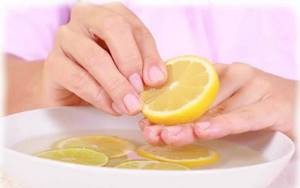
This citrus product is widely used in face masks. It also helps restore damaged structure. Thanks to vitamin C, nails return to their previous condition, become well-groomed and beautiful. In addition, lemon juice will get rid of the unpleasant matte color.
Squeeze the juice from fresh lemon and rub. After 3 minutes, rinse with water.
Vitamin varnish
Vitamin varnishes, or “strengtheners,” can be used both to restore the structure of the nail after shellac, and simply for prevention. Sometimes, in addition to microelements that accelerate the regeneration process of keratin, which our nails are mainly made of, they contain oils, proteins, silk and Kevlar fibers, which seal microcracks and exfoliated scales. The only disadvantage of such coatings is the meager color palette, which is limited to transparent, pink and beige shades, although for the perfect nude this is exactly what you need!
Change your diet

Proper nutrition will help improve your structure. There should be no protein deficiency in the body, and the diet is rich in vitamins and minerals. It is biotin (vitamin B7) that strengthens, so consume more of it. You will find this vitamin in eggs, almonds, avocados or Jerusalem artichokes.
You can also take biotin as a dietary supplement. This will make not only your nails, but also your skin and hair healthy and beautiful.
Varnish film
Along with multi-colored stickers, which were at the peak of popularity in the early 2000s, film varnishes, which can be either plain or with prints, have also returned to fashion. Of course, in order to make a full-fledged manicure with their help, you will have to put in a lot of effort - cut out squares to fit the size of the nail, warm them under a lamp, smooth them well with an orange stick and carefully remove any residue from the edges. But such a coating will allow air to pass through well, last for about two weeks, and due to the printed prints, it allows you to experiment with rather complex patterns, which can be quite difficult to draw on your own.
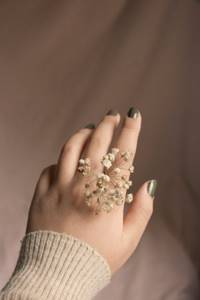
Photo: unsplash.com
In general, of course, you shouldn’t be afraid of shellac and deny yourself the pleasure of doing a manicure with a long-lasting coating. In order to preserve the health of your nails as much as possible, it is important to remember only the basic rules: study the composition of the products used by the master, and avoid obvious toxic elements that can cause severe allergies - camphor, formaldehyde resins, toluene, xylene and others. Also, when you get tired of the coating, in no case should you just scrape it off your nails, otherwise you can seriously damage their top keratin layer. It’s better to spend a little more time on this procedure, and then give your nails a few days to recover - and then you’ll be fine with them. everything will be all right.
Fungal infection
If the nail comes off due to fungal spores entering the damaged plate, then the cause may be poor-quality processing of manicure tools and the unprofessionalism of the master. An additional dense coating of gel polish creates favorable conditions for its active reproduction.
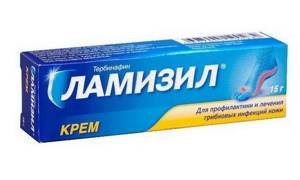
Lamisil
At the initial stage, the clinical picture is similar to onycholysis, when the nail comes off and becomes yellow, but if left untreated, it becomes rough, deformed, crumbles and thickens. An accurate diagnosis is established after laboratory diagnosis of part of the cut plate.
Preventive procedures
- To prevent weakened nails, first of all, we must not forget that shellac is not our native material, and therefore our nails need a “rest” from it. During such a “rest”, nails need care. It's time to make homemade wraps or baths, vitamin mixtures, etc. Every evening you should do a light massage to improve blood flow to the skin and speed up nail restoration.
- In second place for the prevention of weakened nails is the question of proper nutrition. Fatty acids, vitamins and calcium are especially important for nails, so I must contain nuts, honey or other vitamin supplements, fruits and cottage cheese.
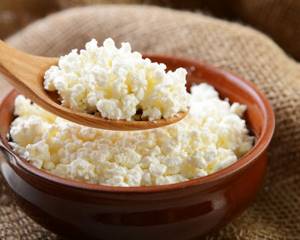
- When using any restoration products, you need to understand that only a fully grown nail plate will be truly strong and healthy. Therefore, experts do not recommend wearing a long manicure if your nails are weakened. Due to the mobility of the weakened nail plate, nails quickly break and can even damage the soft tissues under the nail. The best way is to file off the nail as it grows.
- If you still don’t have enough time for proper nail care, you can use a very quick way to help at least the already growing nails to be stronger and healthier. This is a product for nourishing and moisturizing the cuticle. You can buy ready-made oil, or you can make it at home (choose one of the base oils and add a few drops of essential oils and liquid vitamin A and E, which can be purchased at the pharmacy). This oil can be applied to the cuticles at night, lightly rubbing it into the skin.
With proper care and not overusing procedures such as shellac, your nails will always have an aesthetically healthy appearance. Shellac's application technology is slightly safer than regular gel polish. If the application technology is followed, the nail is practically not injured. With reasonable use of shellac (meaning that time is also allocated for nail restoration), the pens will always look great.
From which we can draw 2 conclusions:
- The procedure should be carried out by a good master, or get a clear example and good advice from a master about the individuality of your nail plate;
- For good quality nails and safety for your health, after any procedure you need a “rest” for at least 1-2 months.
Liked? Share with your friends!
Why does coating affect nails so much?
Nails after gel polish may lose their strength due to the nature of the manicure. During the procedure, the plates are covered with several layers of materials: base, shellac, top. As a result, they do not receive enough air, and they begin to peel off and break.
The negative impact also extends to the skin. Gel polish dries only under a special lamp, prolonged exposure to the rays of which dries it out and sometimes even leads to burns.
One more point: preparation for coating. It is known that shellac adheres better to rough surfaces. Because of this, before applying the base and other layers, preliminary sanding with a buffer is necessary. Prolonged and overzealous exposure leads to the removal of the top layer of the plate, its delamination, and the appearance of bumps.
Problems after removing shellac
To remove such varnish, it is not enough to wipe your nails with a liquid containing ammonia. Aggressive substances are applied to cotton pads, then placed on plates and covered with foil or special clips. As a result, the liquid heats up and penetrates not only the gel polish, but also the plates themselves. If this method is used too often, after a while the nails will begin to hurt even from contact with hot water.
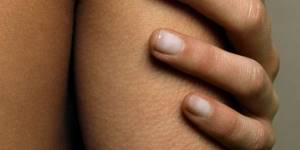
Problems after removing shellac
No less traumatic methods are to cut off the coating or remove it with a milling cutter. Even good specialists cannot remove only gel polish and always touch the top part of the nail. Over time, it begins to deteriorate and needs treatment.
Treatment
What to do when your fingernails come off due to fungus? First of all, you should stop using gel polish for the next 6 months. It is necessary to contact a dermatologist, where a group of medications is prescribed:
- Local antifungal drugs: Terbix Spray; Lotion Candide; Ointments: Lamisil, Mycozan, Exoderil, Mycozoral; Varnishes: Oflomelid, Lotseril, Batrafen.
- Antifungal drugs used orally for systemic action: Itraconazole, Ketoconazole, Terbinafine.
- Mechanical nail removal in an advanced stage.
- General strengthening of the body: balanced nutrition, consumption of lactic acid products, sea fish, fish oil. During therapy, exclude sugar and sweets. Taking vitamin complexes.

Vitamin complex
Why is it not advisable to treat the fungus yourself? People purchase a single-acting drug, but with a mycotic infection, a complex effect on the spores is required for complete elimination. Depending on the type of fungus and the stage of the disease, individual remedies and duration of therapy are selected.
Why use laser treatment?
Laser beams are necessary when conservative drug therapy does not bring the expected effect. The peculiarity of the laser is its penetration into deep layers without damaging healthy areas.
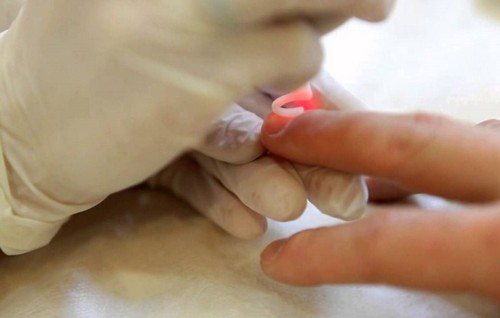
Laser treatment
Careful handling of your fingernails will help avoid changes in the structure of the plate. Timely seeking medical help and adequate therapy will eliminate the disease in a short time.
Lack of vitamin D and calcium
If the body lacks vitamins and microelements, the nails will also peel off. Therefore, it is worth monitoring the level of these microelements. Vitamin D deficiency can be recognized by external signs:
- pain in muscles and joints;
- increased fatigue;
- digestive problems and others.
Calcium deficiency is usually recognized quickly by brittle nails and dental problems.

Vitamins for beauty. How to improve the condition of your skin, hair and nails Read more
Onychomycosis
There may also be a fungal infection of the nail, but it is impossible to distinguish it from the previous group. “Here you need to go to a doctor to differentiate, be sure to take scrapings and samples. All this must be done, because you can’t distinguish onychodystrophy from onisomycosis by eye,” explains Tatyana Egorova.
At the same time, you need to understand that the analysis should be done correctly. “This is only a laboratory diagnosis, and you need to take three tests to get an accurate result. The nail is wrapped in a plaster, you have to walk like this for three days, without washing your feet, only then submit scrapings. If you wash your feet, treat them, or apply something on them, there will be no result—the tests won’t show anything. You can get tested at a regular skin and venous dispensary,” notes the dermatologist.


